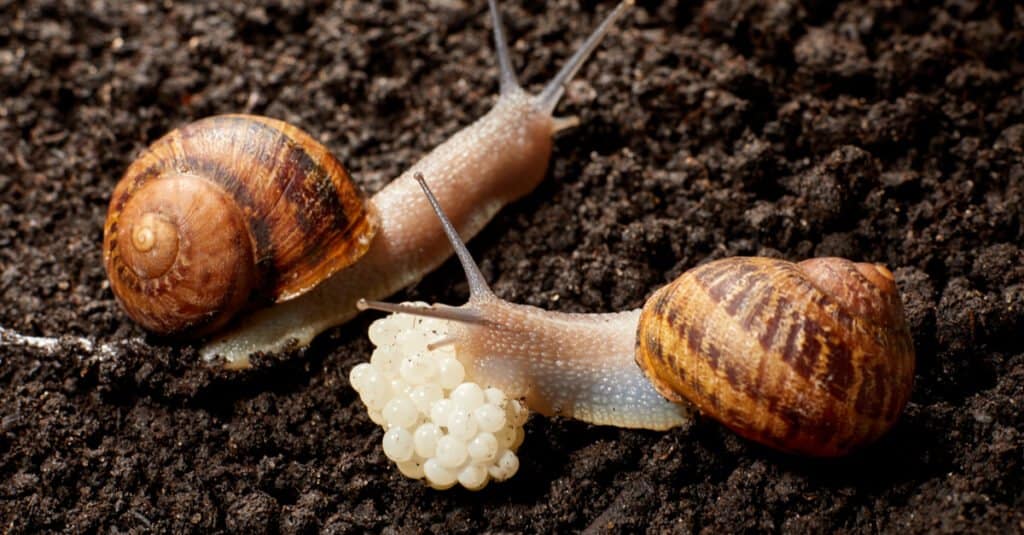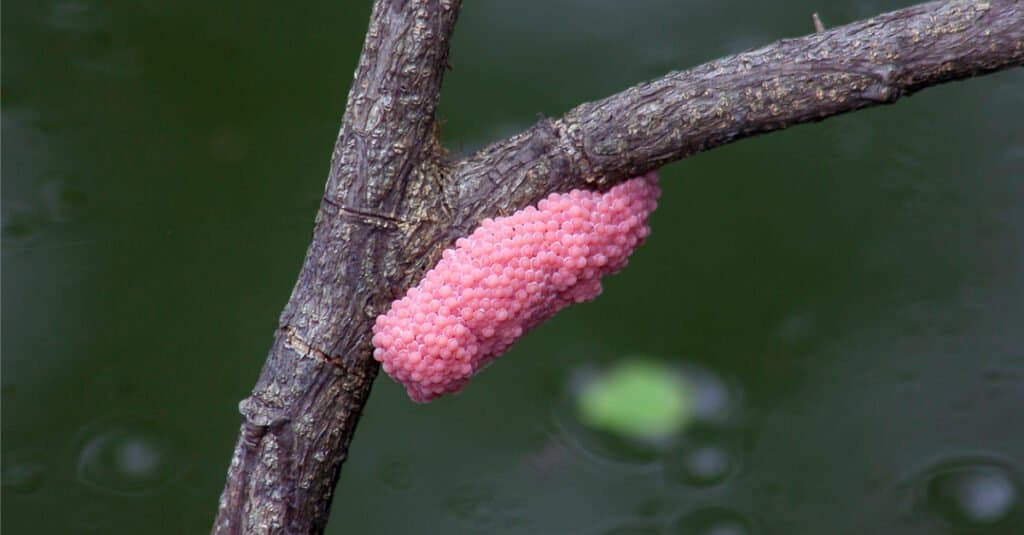Snails don’t seem to be that interesting, but in truth, they are some of the most diverse creatures on the planet! We’ve all seen a garden snail slowly making its way across a sidewalk. But did you know that some snails have poison darts that are strong enough to kill multiple men? Let’s take a look at snails, specifically, their eggs. Snail eggs are super strange, but we can learn some interesting facts about them. Let’s discover: Snail Eggs: What They Look Like & 7 Fun Facts.
What do Snail Eggs Look Like?

Some snail eggs can be pink or reddish in color, but a clear egg with a small black dot within is much more common.
©Alexandr Jitarev/Shutterstock.com
Generally, snail eggs will vary in look, depending on the species that laid them. This is true across most animal species (think about how different bird eggs can be). Some snail eggs are designed to float in water, while others are made to stick to the sides of various plants!
Still, there are some generalities that are true across most snail eggs that we would encounter. Since snails are so small, their eggs are too. Most snail eggs are going to be the size of a mustard seed or smaller. In most cases, you wouldn’t even notice them unless you were looking. When it comes to color, many snail eggs are going to be a pale white or clear color, depending on the species.
Some snail eggs can be pink or reddish in color, but a clear egg with a small black dot within is much more common. Additionally, they are often clumped together with a sticky substance. Snails will lay them in these clumps to keep them together so they don’t disperse and potentially land somewhere that is dangerous.
Knowing some basic information on snail eggs, let’s take a more specific look at some cool (or just strange) facts about them!
Snail Egg Fact #1: They are Fertilized in Different Ways
Snails can get the job done with or without a man! Most species of snails are hermaphrodites and have both male and female sex organs. Still, they must mate with one another to reproduce in most situations. In many species, they will mate and then store the sperm for later use, sometimes for up to a year! Snails have the capability to mate up to five times a year.
In snails that live near water, one will lay the eggs while the other releases sperm into the water. The sperm then swim around, hopefully making their way to the eggs and fertilizing them.
Snail Egg Fact #2: Some People Eat Them

A single ounce of snail caviar can run as much as $70 just because of how uncommon it is.
©Zebra-Studio/Shutterstock.com
While “snail caviar” doesn’t sound appetizing, it’s actually a real food that some people intentionally eat! The caviar is made of fresh land snail eggs and is said to have an earthy taste. In fact, some people liken it to baked asparagus. It can cost a pretty penny, too! A single ounce of snail caviar can run as much as $70 just because of how uncommon it is. It’s rare in Europe and even rarer in the United States. Since the snails only lay 100 eggs a year, it is a labor-intensive process to acquire them.
It’s often served as a salad or soup garnish, but some people will eat it like fish caviar, simply eating it from a spoon or putting a small amount on a piece of toast.
Snail Egg Fact #3: It Doesn’t Take Long for Them to Hatch
After a snail has mated, it will usually lay eggs soon after. Many fish tank owners will find that their tank snails have laid eggs. Once they have been laid, they usually will sit for 2-4 weeks before hatching. For anyone with fish in the tank, ensuring that the fish don’t partake in any fresh-made snail caviar is important!
Before they hatch, snail eggs will generally change shades and darken inside. The interior darkening is the baby snail growing inside.
Snail Egg Fact #4: Some Snail Eggs are Dangerous to Touch

A human touching the snail of the eggs has a chance of getting Rat Lungworm eggs in their bodies.
©iStock.com/Puripat penpun
Snails can be hosts to really harmful parasites and bacteria. The apple snail, for example, is a known carrier of the Rat Lungworm. In rats, the worm simply passes through the feces, often into the water supply. When the snails eat the rat feces or go near the water, they pick up the eggs and parasites. When they lay their eggs, the parasite is passed on. A human touching the snail of the eggs has a chance of getting Rat Lungworm eggs in their bodies. Since the worms don’t know where to go (they are supposed to be in rats), they end up in the brain and cause damage, eventually causing the person to go insane and die.
Snail Egg Fact #5: Snails Lay Their Eggs in Interesting Places
Land snails often lay their eggs in the dirt. They prefer to dig a small hole in the dirt where they lay the eggs, safe from most predators. Marine snails often lay their eggs above the waterline near or on a rock where they can anchor the eggs. Fully aquatic snails will lay their eggs in clumps with a “glue” holding them together. They will usually stick to the inside of aquariums or are placed on vegetation.
Snail Egg Fact #6: Snail Farming is Known as Heliciculture

Although snail caviar is becoming more popular, escargot is still the main reason for snail farming.
©RossHelen/Shutterstock.com
Snail farming is known as heliciculture. The two main reasons for snail farming are escargot (cooked snails) and snail caviar. Escargot is the most common, but snail caviar is becoming more popular. France and Poland are the most common places for snails to be farmed for their eggs.
Snail Egg Fact #7: Snail Eggs Were Called “Pearls of Aphrodite”
The ancient world thought that snail eggs were an aphrodisiac and used them to increase their sexual prowess. They were nicknamed “Pearls of Aphrodite.” In fact, one company from Latin America is currently selling their own Pearls of Aphrodite, hoping to export over 300kg of it a year!
How Many Eggs Do Snails Lay Per Month?

The average snail, like the garden snail, will produce 86 eggs per cycle.
©iStock.com/1284919455
There are more than 60,000 species of snails found throughout the world and each species is different in many ways. While some may lay their eggs out of the water, where the juvenile snails will then return to the water after hatching, there are others that lay eggs in in soil. Each species also varies in the amount of eggs they may lay.
Snails are able to lay eggs multiple times per year, and there are some that are able to even lay eggs as frequently as once or more per month. The amount of eggs can be anywhere from five eggs to 200 eggs in one bunch, and there have even been some that have laid as many as 600 at one time. The average snail will lay 86 eggs per cycle.
The photo featured at the top of this post is © Zebra-Studio/Shutterstock.com
Thank you for reading! Have some feedback for us? Contact the AZ Animals editorial team.






